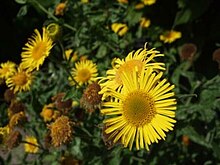| Pulicaria dysenterica | |
|---|---|

| |
| Scientific classification | |
| Kingdom: | Plantae |
| Clade: | Tracheophytes |
| Clade: | Angiosperms |
| Clade: | Eudicots |
| Clade: | Asterids |
| Order: | Asterales |
| Family: | Asteraceae |
| Genus: | Pulicaria |
| Species: | P. dysenterica
|
| Binomial name | |
| Pulicaria dysenterica | |
Pulicaria dysenterica, the common fleabane,[1] or, in North America, meadow false fleabane,[2] is a species of fleabane in the family Asteraceae. It is native to Europe and western Asia where it grows in a variety of habitats ranging from semi-arid Mediterranean woodlands to wetter situations.[3] Pulicaria dysenterica is perennial and can form dense clusters of plants, spreading by its roots. It flowers at its maximum height of about 60 centimetres (2.0 ft).[4] Leaves are alternately arranged and clasp the stem, which itself contains a salty-astringent liquid. The yellow inflorescences are typically composed of a prominent centre of 40–100 disc florets surrounded by 20–30 narrow, pistillate ray florets. When setting seed the flower heads reflex.[5]
Common fleabane is the main food plant for the fleabane tortoise beetle (Cassida murraea),[6] and for four micromoths, Apodia bifractella,[7] Ptocheuusa paupella,[8] dusky plume (Oidaematophorus lithodactyla)[9] and Digitivalva pulicariae.[10]
Fleabane's common name comes from its former use as an incense to drive away insects.[5] Other past uses include treatments for dysentery and unspecified ocular maladies.[3]
- ^ BSBI List 2007 (xls). Botanical Society of Britain and Ireland. Archived from the original (xls) on 2015-06-26. Retrieved 2014-10-17.
- ^ USDA, NRCS (n.d.). "Pulicaria dysenterica". The PLANTS Database (plants.usda.gov). Greensboro, North Carolina: National Plant Data Team. Retrieved 16 October 2015.
- ^ a b "Fleabane (Pulicaria Dysenterica, Gray)".
- ^ "Pulicaria dysenterica Fleabane, Meadow false fleabane PFAF Plant Database".
- ^ a b "Pulicaria in Flora of North America @". Efloras.org. Retrieved 2022-05-01.
- ^ "Cassida murraea Linnaeus, 1767 | UK Beetle Recording".
- ^ "Apodia bifractella - UKMoths".
- ^ "Ptocheuusa paupella - UKMoths".
- ^ "Dusky Plume Oidaematophorus lithodactyla - UKMoths".
- ^ "Digitivalva pulicariae - UKMoths".